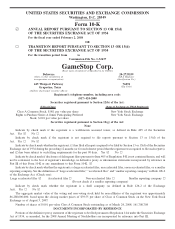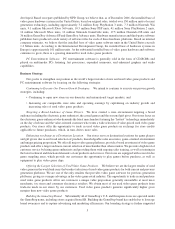GameStop 2007 Annual Report Download - page 19
Download and view the complete annual report
Please find page 19 of the 2007 GameStop annual report below. You can navigate through the pages in the report by either clicking on the pages listed below, or by using the keyword search tool below to find specific information within the annual report.a market research firm, estimates that retail sales of video game hardware and software and PC entertainment
software totaled approximately $15.6 billion in Europe in 2007. The NPD Group has reported that video game retail
sales in Canada were approximately $1.5 billion in 2007. According to the independent market research group GfK,
the Australian market for video game products was approximately $1.1 billion in 2007.
New Video Game Products. The Entertainment Software Association, or ESA, estimates that 67% of all
American heads of households play video or computer games. We expect the following trends to result in increased
sales of video game products:
•Hardware Platform Technology Evolution. Video game hardware has evolved significantly from the early
products launched in the 1980s. The processing speed of video game hardware has increased from 8-bit
speeds in the 1980s to high speed processors in next-generation systems, such as the Sony PlayStation 3
launched in November 2006 in North America and the first quarter of fiscal 2007 in Australia and Europe,
the Nintendo Wii launched in November 2006 worldwide, and Microsoft Xbox 360, launched in the fourth
quarter of 2005 in North America and Europe and the first quarter of 2006 in Australia. In addition, portable
handheld video game devices have evolved from the 8-bit Nintendo Game Boy to the 128-bit Nintendo DS,
which was introduced in November 2004 in North America and the first quarter of 2005 in Australia and
Europe, and the Sony PlayStation Portable (the “PSP”), which was introduced in March 2005 in North
America and September 2005 in Australia and Europe. Technological developments in both chip processing
speed and data storage have provided significant improvements in advanced graphics and audio quality,
which allow software developers to create more advanced games, encourage existing players to upgrade
their hardware platforms and attract new video game players to purchase an initial system. As general
computer technology advances, we expect video game technology to make similar advances.
•Next-Generation Systems Provide Multiple Capabilities Beyond Gaming. Many next-generation hardware
platforms, including the Sony PlayStation 2 and 3 and Microsoft Xbox and Xbox 360, utilize a DVD
software format and have the potential to serve as multi-purpose entertainment centers by doubling as a
player for DVD movies and compact discs. In addition, the Sony PlayStation 3 and PSP, the Nintendo DS and
Wii and Microsoft Xbox 360 all provide internet connectivity and the Sony PlayStation 3 plays Blu-ray
discs.
•Backward Compatibility. The Sony PlayStation 2 and 3, the Nintendo DS and Wii and Microsoft Xbox 360
are, to some extent, backward compatible, meaning that titles produced for the earlier version of the
hardware platform may be used on the new hardware platform. We believe that during the initial launch
phase of next-generation platforms, backward compatibility results in more stable industry growth because
the decrease in consumer demand for products associated with existing hardware platforms that typically
precedes the release of next-generation hardware platforms is diminished.
•Introduction of Next-Generation Hardware Platforms Drives Software Demand. Sales of video game
software generally increase as next-generation platforms mature and gain wider acceptance. Historically,
when a new platform is released, a limited number of compatible game titles are immediately available, but
the selection grows rapidly as manufacturers and third-party publishers develop and release game titles for
that new platform.
•Broadening Demographic Appeal. While the typical electronic game enthusiast is male between the ages
of 14 and 35, the electronic game industry is broadening its appeal. More females are playing electronic
video games, in part due to the development of video game products that appeal to them. According to ESA,
approximately 38% of all electronic game players are female. ESA also states that 36% of parents say they
play computer and video games and that 80% of gamer parents play video games with their kids. According
to ESA, the average game player is 33 years old; however, the video game market also includes approx-
imately 24% of Americans over the age of 50. In addition, the availability of used video game products for
sale has enabled a lower-economic demographic, that may not have been able to afford the considerably
more expensive new video game products, to participate in the video game industry.
Used Video Game Products. As the installed base of video game hardware platforms has increased and new
hardware platforms are introduced, a considerable market for used video game hardware and software has
4
























